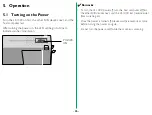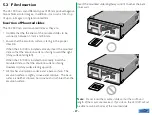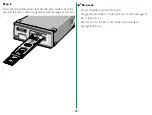
- 33 -
6. Troubleshooting
If something unusual should occur, please check the following
items before you assume that there is a unit failure. For more
details, refer to the Troubleshooting section of the software
manual.
Scanning cannot be performed.
• Is the SCSI cable connected?
Connect the SCSI cable.
• Are you using the supplied SCSI cable?
Use the supplied SCSI cable
• Is the end of the connected SCSI cable terminated?
Connect the terminator.
• Is the SCSI ID number different from the SCSI ID of other
devices?
Change the ID number if it is duplicated.
• Are you using a recommended SCSI board ? (For Windows
version)
Use a recommended SCSI board.
• Are the numbers you have set for I/O, INT and DMA for
the SCSI board different from those for other boards? (For
Windows version)
• Does your system satisfy our recommended system
requirements?
Provide the recommended system.
• Have you installed software?
For information on installing and operating software, refer to
the software manual provided with the unit.
• Have you properly set the configuration, such as
CONFIG.SYS ?
If you have installed applications for Windows, for instance,
note that the configuration may change automatically. (For
Windows version)
Poor image quality.
• Have you set the film properly?
Set the film properly.
• Can you see dust on the film?
Remove dust on the film with a blower or photographic
brush.
• Was the unit subjected to vibration during the scanning
operation?
Place the unit where it will not be subjected to vibration or
physical shocks.
• Are you using utility software properly?
For details, please refer to the manual for your software.
The auto slide feeder display LED does not light.
• Is the LS-1000 power on?
Turn on the power.
• Are the LS-1000 and the auto slide feeder properly
connected?
Switch off the LS-1000 and re-connect.




































